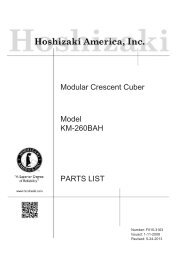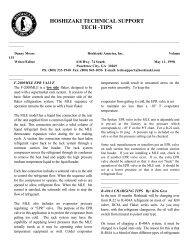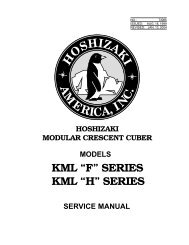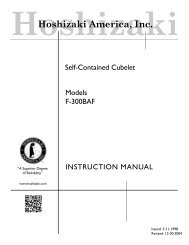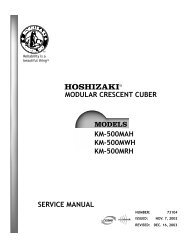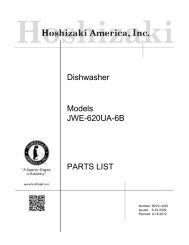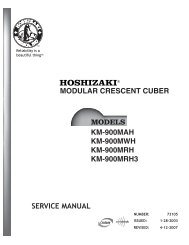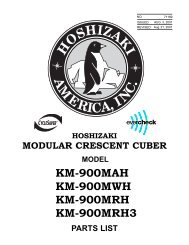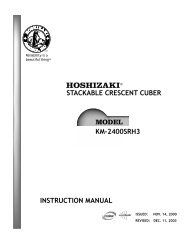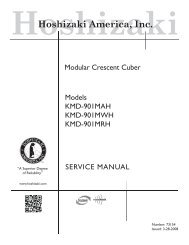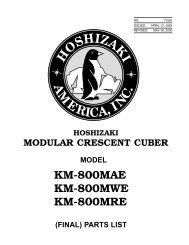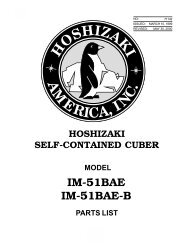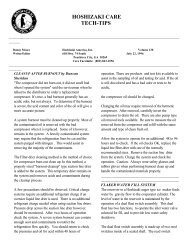hoshizaki technical support tech -tips - Hoshizaki America, Inc.
hoshizaki technical support tech -tips - Hoshizaki America, Inc.
hoshizaki technical support tech -tips - Hoshizaki America, Inc.
Create successful ePaper yourself
Turn your PDF publications into a flip-book with our unique Google optimized e-Paper software.
HOSHIZAKI TECHNICAL SUPPORT<br />
TECH -TIPS<br />
_________________________________________________________________________________________________________<br />
____<br />
Danny Moore <strong>Hoshizaki</strong> <strong>America</strong>, <strong>Inc</strong>. Volume 148<br />
Writer/Editor 618 Hwy. 74 South February 9, 1998<br />
Peachtree City, GA 30269<br />
Ph: (800) 233-1940 Fax: (800) 843-1056 E-mail: <strong>tech</strong><strong>support</strong>@<strong>hoshizaki</strong>.com<br />
_________________________________________________________________________________________________________<br />
____<br />
“E” CONTROL BOARD PART NUMBER<br />
In the last issue of Tech-Tips, we introduced you to<br />
the “E” control board. You will find that there are<br />
actually two different part numbers associated with<br />
this new board. The part number provided in last<br />
months issue (2A0863-01) is for the original<br />
production board which is installed in the unit on the<br />
assembly line. This board does not have the function<br />
switch marked “C / ALP” and will not be provided to<br />
the field for service replacement.<br />
The universal replacement “E” board # 2A0863-02<br />
will include this function switch and will sub for the<br />
Alpine board # 2U0139-01. This one board will<br />
replace a “C”, Alpine, or “E” board in the field. Please<br />
make this correction in your parts files.<br />
__________________________________________<br />
__________________________________________<br />
R-404A SCHEDULE<br />
As you may know, <strong>Hoshizaki</strong> is in the process of<br />
changing over production from R-22 (HCFC)<br />
refrigerant to R-404A (HFC) refrigerant. At present,<br />
we have two R-404A models available for sale. They<br />
are the new KM-150BAF self contained cuber and the<br />
DCM-240BAF cubelet machine.<br />
Other R-404A units are in the redesign process and will<br />
be made available throughout 1998 and into 1999 as<br />
the product change over is completed. The complete<br />
lineup of cubers, flakers and DCM ice makers will be<br />
changed over to R-404A refrigerant.<br />
R-404A models will be made available for sale as they<br />
are produced. Obviously this will coincide with the<br />
reduction of R-22 equipment inventories. The next KM<br />
models to be produced and released for sale will be the<br />
KM-1200SAF / SRF and the<br />
KML-400MWF. These should be made available<br />
around mid 1998. Other models will follow the end of<br />
the 3 rd quarter and beyond.<br />
From a <strong><strong>tech</strong>nical</strong> standpoint, the R-404A unit will revert<br />
back to the simple R-502 refrigerant system design.<br />
The compressor discharge temperature is slightly less<br />
than that of R-502 so the bypass cooling components<br />
will not be included. You will find that the system<br />
pressures will increase slightly. While<br />
R-404A refrigerant is more efficient in the freeze cycle,<br />
the cooler discharge gas will make for a slightly longer<br />
harvest time. This balances out to provide total cycle<br />
times and production similar to previous models.<br />
An R-404A model Tech-Specs Pocket guide is in the<br />
planning stages. We will delay printing until there are<br />
enough R-404A units available to generate a complete<br />
guide. In the mean time, watch for Service Bulletins<br />
which provide <strong><strong>tech</strong>nical</strong> service information on the new<br />
R-404A products.<br />
__________________________________________<br />
__________________________________________<br />
WATER TREATMENT<br />
Potable water quality differs throughout the country and<br />
can vary across town or even across the street. Water<br />
related ice machine service problems increase<br />
proportionately as water quality declines. Filter<br />
manufactures employ water filter experts who specialize<br />
in solving water quality issues. These experts are very<br />
beneficial in helping to resolve severe water problems.
Fortunately, the KM cuber models have some flexible<br />
adjustments on the control board to vary the built-in<br />
flush or cleaning ability of the unit. This<br />
serves to eliminate the need for filtration in some areas,<br />
but not in all. These severe cases require specialized<br />
water treatment systems.<br />
If heavy sediment is present, a simple sediment<br />
“canister” type filter that is properly sized will suffice.<br />
This will remove the big “sticks and stones”. If heavy<br />
mineral content or bacteria is present, a specialized<br />
treatment may be necessary.<br />
The first step in resolving severe problems is to test the<br />
water entering the ice machine. Filter manufacturers can<br />
help you with this step. Most provide simple water test<br />
kits and charts which lead you to the best option<br />
for resolving your specific problem. These tests<br />
generally check the pH of the water. Some filter<br />
manufacturers provide water sample bottles and can<br />
conduct a more elaborate test report on your water<br />
quality. These tests will isolate the type of minerals or<br />
bacteria in the water sample and the manufacturer will<br />
suggest a course of action to correct the problem.<br />
Since different minerals and bacteria levels require<br />
different types of treatment, your best bet is to rely on<br />
the filter manufacturers for treatment recommendations.<br />
_________________________________________<br />
_________________________________________<br />
SERVICE Q & A<br />
The next few issues, we will be covering diagnosis of<br />
the alarm features of the “E” control board.<br />
Question; What do I check if I am servicing a unit with<br />
an “E” control board installed and it is beeping 1 beep<br />
every 3 seconds.<br />
Answer by: Chad Darnell. When servicing a unit that<br />
has the new “E” control board, there are several<br />
audible alarms which could occur. We will be<br />
discussing the first alarm feature which is the HIGH<br />
TEMPERATURE SAFETY. This safety results in an<br />
alarm of 1 beep every 3 seconds.<br />
The HIGH TEMPERATURE SAFETY is activated,<br />
when the thermistor which is mounted on the suction<br />
line reaches a temperature of 127° F. When this occurs<br />
it will shut the unit down, trigger this alarm, and lock it<br />
out on a manual reset safety.<br />
Some of the reasons for a High Temperature safety<br />
alarm are as follows. You will find these possibilities<br />
included on the control board diagnostic label located in<br />
the compressor compartment. Follow the instructions<br />
provided on the label to reset the alarm and check these<br />
areas to locate the problem.<br />
First, check to see if there is a mechanical problem with<br />
the hot gas valve sticking open or with the control board<br />
relay sticking. Check for a temperature differential<br />
across the hot gas valve. To check for a sticking relay,<br />
use a volt meter to check for voltage on pink wire, pin #<br />
2 on the K1 connector.<br />
Hot water migration can also cause this. This typically<br />
happens at night when the only piece of equipment<br />
requiring water flow is the ice machine. Hot water<br />
migration is a tough problem to find and to prove to the<br />
customer. The best way to determine that this is<br />
happening is to place a temperature recorder on the inlet<br />
water line of the ice machine. The recorder will show<br />
when migration occurs. Usually hot water migration is<br />
due to a defective mixing valve in the existing plumbing.<br />
A good place to check is the pre-wash area at the<br />
dishwasher.<br />
Another possibility is a stuck head master on a remote<br />
air cooled condenser unit operating in a high ambient<br />
condition. The best way to check for this is to carefully<br />
touch the liquid line connection at the rear of the unit.<br />
Also, check for heat at the inlet pipe to the receiver<br />
tank. If these areas are hot, the head master is likely<br />
stuck in the bypass mode.<br />
The last possibility is a shorted thermistor. If the<br />
thermistor reads approximately 500 ohms or less the<br />
control board will lock out on this safety. A shorted<br />
thermistor will signal zero ohms and cause repeated shut<br />
down on HIGH TEMPERATURE SAFETY.<br />
By following these suggestions, you should be able to<br />
resolve the problem that caused the HIGH<br />
TEMPERATURE SAFETY alarm.
__________________________________________<br />
__________________________________________<br />
COMING NEXT MONTH...<br />
1. Head Master Diagnosis<br />
2. Polyol Ester Oils<br />
3. Service Q & A Volume 148 Page 2



